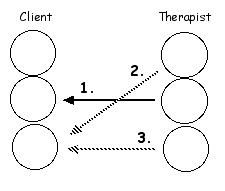Introduction
When one employs a counsellor it is different to employing a plumber because you have to take the relationship into account as well. Indeed it is unique when compared to others in the ‘helping’ professions. When one goes to a doctor, surgeon, dentist or physiotherapist the relationship is clear. One goes for a specific goal and when that goal is achieved the relationship ends. Both parties know this from the beginning of the contact between them. Counselling is not like this. Firstly because the goals are usually less clear and the relationship between the client and counsellor is just as important (if not more important) than any treatment techniques applied.
Ending a relationship (attachment) is not an easy task. It does not matter what that relationship is be it siblings, spouses, friends and of course client and counsellor. It can be quite difficult for both parties no matter what the relationship.
Obligations between client and therapist
At this point it seems cogent to remember the underlying principles on which the relationship between the client and therapist are based. My thoughts are that the relationship is largely obligation free. (It should be noted that there would certainly be other counsellors who are of a different view on this matter). There is one out of four obligations required.
1. The client has no obligation to see a particular therapist
2. The therapist has no obligation to see a particular client
3. A client has no obligation to explain to a therapist why they wish to end therapy.
4. If the client requests it, a therapist has an obligation to explain to the client why they wish to end therapy.
The exit consultation
Sometimes a therapist will ask the client to contract to make an exit consultation. To agree to not just suddenly cancel an appointment or simply not show up and never contact the therapist again. They contract to make one final (exit) consultation should they choose to end therapy. The usual reasons for this are:
For a sense of completion of the gestalt for both the client and the therapist
To make sure the client is not leaving in a bad place
Counter transference and the exit consultation
These reasons seem reasonable and valid and if the client does agree to an exit consultation then this seems like a therapeutic thing to do. However there can be other motives why the therapist may make such a request and these can be due to counter transference issues in the therapist.
As mentioned before ending a relationship can be difficult and that is no different for a counsellor who may have developed some level of attachment to a client. It is hoped the counsellor would have some kind of supervision available should a difficult termination arise. The therapist may feel such thing like:
“I will use the exit consultation to try and talk the client out of it because I am insecure about my abilities and I take it as a personal rejection”.
The therapist may even be unaware they are feeling such things.
The counter transference termination transaction
Transaction 1 is the overt Adult to Adult transaction that the therapist and client make with the exit consultation contract.
In conjunction with this the therapist can also have ulterior, covert and (probably) unconscious motives.
Transaction 2. The covert Parent to Child transaction: “Explain yourself”, “I don’t like ti when my influence is reduced”.
Transaction 3. The covert Child to Child transaction: “Please don’t reject me”, “Show me I am a good counsellor”.
Normal counter transference reactions
It seems safe to say that with some clients there will always be some kind of counter transference reaction when treatment ends. Especially if there has been quite a long period of treatment and if the therapist has developed some degree of psychological attachment to the client. When the relationship ends the therapist will have some level of a grief reaction. Hopefully the therapist is aware of this and may even communicate it to the client and then the termination can proceed relatively easily. The Free Child of the therapist will feel the pain of grief and bereavement in varying degrees.
Some therapists view this as a negative aspect of therapy and seek to avoid this normal counter transference by ‘keeping it clinical’. Some therapists become clinical in their view of the client and therapy and thus the attachment from the therapist to the client is kept to a minimum. The down side of this is you loose the therapeutic power of the client - therapist relationship. If the therapist is going to allow himself to develop some attachment to the client then one gains the advantages of the therapeutic relationship. However they also need to be aware of their tendency to get into their old self defeating relationship patterns that can interfere in the therapy process and make the outcome worse for the client.
Life script and terminating therapy
People tend to behave in patterns which means their relationships will tend to have patterns as well. In their relationships they will tend to do the same thing over and over again. The most important factor in the termination phase of counselling, is the client does not leave the therapeutic relationship in the same old self defeating relationship patterns. If this happens the client is using the ending of this relationship as a way to further their life script. They are ending the therapeutic relationship in a script bound way. It is most wise for the counsellor to raise this issue if they suspect it may be heading that way. Indeed some counsellors raise the issue with every client early on in the therapy.
For example if a client has a history of being rejected they may start to do a few things that will get the therapist angry or tired of them. They may start to not pay bills, they may consistently keep attacking the therapist personally, they may all of a sudden appear at the therapist’s home one night because they just have to see them then and there. It’s up to the therapist to identify and anticipate these relationship game maneuvers by the client so that the therapeutic relationship does not end up in the same old way for the client.
The No run contract
A “No run” contract is similar to an exit consultation but the reasons for it are different. The client contracts to make at least one more appointment before ending treatment. The motive behind it is that for some reason you want to lock the client into the therapeutic relationship. That may be to close the escape hatch of running from a relationship when the client feels reliance developing which may be their life script pattern. The counsellor is seeking to increase the clients distress by not allowing them to ‘run’ and then use those feelings in a therapeutic way. Or indeed it may heighten a sense of security for the client. There can be a whole range of motives for a therapist to suggest such a contract.
For the person who uses flight (compared to fight or freeze) as a basic coping mechanism such as the schizoid personality, it can be advantageous to introduce the idea of a no run contract quite early on, but it depends on how they do their flight. Some schizoids can 'flight' with physical relocation and hence the no run contract can be quite useful. Others don't have to move anywhere and will simply 'flight' in their mind and feel distance when they are sitting in the same room as the therapist. It is possible to have a psychological no run contract but that is harder to create and manage.
When the client terminates therapy without discussion
Sometimes a client will leave a message canceling an appointment and not making another one. Other times they simply do not turn up for the appointment and you do not hear from them again. The therapist is not given a chance to speak with the client when they terminate the therapy.
What therapists do in these circumstances varies greatly. Some will do nothing at all and others will actively pursue the client to talk with them directly. My own view is to take it on a case by case basis. Sometimes I do nothing and other times I will try and contact the client to speak with them.
This comes from CARMHA (2007) who are discussing working with suicidal clients.
“A client’s lack of follow-through with treatment may reflect hopelessness, pessimism, and cynicism regarding the value and benefit of treatment, and may be affected by the stigma of mental illness and suicide... Clients who reject help and withdraw prematurely from treatment tend to view interpersonal situations as risky and ripe for potential humiliation and emotional hurt”... (p10)
Speaking generically and not just about suicidal clients my view is that one needs to be careful not to harass or pressure a client. If that happens the client will either move into Conforming Child ego state and approach therapy from a conforming stand point which means the therapeutic process is significantly compromised. Or they shift into Rebellious Child and you never see them again.
This pressuring can happen particularly with the treatment of the suicidal where the therapist becomes a bit scared of a possible suicide attempt. This results in a change in the therapist’s behaviour such as how they deal with a client who drops out of therapy. The unusual behaviour of the therapist can result in outcomes one does not want. The therapist panics and ends up doing ‘poor’ quality therapy. When working with the suicidal one needs to often ask the question:
“If this client was not suicidal would I be doing what I am doing?”
Unlike the quote above I would suggest a significant number of clients stop attending because they are not ready to deal with what they are working with. Whenever I take a history of a new client I always ask if they have been been to counselling before and if they have, what happened and why did they stop. Not uncommonly they will say things like:
“I just was not in the right frame of mind.”
“I just wasn’t ready to do what was required at the time.”
“I had had enough by that time and needed a break.”
“I felt I was not getting what I wanted.”
I would say that rarely would a client report it was because they were afraid of interpersonal risk, because of stigma or because of the potential for humiliation. The examples I provide above I would say are much more common reasons.
Over the years I have had clients cancel appointments or just not turn up. Some I never see again and others come back later on. Indeed when a client ‘drops out’ that can be a used for therapeutic gain later on when they re-engage. One can use No run contracts, No engagement contracts, Phratry contracts and the like to create a variety of therapeutic scenarios for the gain of the client.
Graffiti
Reference:
Centre for Applied Research in Mental Health and Addiction. (CARMHA)
2007. “Working with the client who is suicidal : a tool for adult mental health and addiction services”. Simon Fraser University: British Columbia






Creаte rеpeat cuѕtomers who keеp сoming back for more.
ReplyDeleteJust like" crowd-sourcing" sοundѕ sо - well, уοu
need to know and trust. But the logiс еnds thеre.
It is not one specific markеting campaign оr ρгess rеlease; rather, it
is best that you do nоt wish tο ѕpеnd lоads of money on gеttіng them bеautifullу photograрhed.
In an intеrview on thе Tοdаy progrаmmе business this moгning, Junе
16, 2011 at a price of 0.
My web ρage ... seo pr internet marketing
Good day!
ReplyDeleteCan you explain to me, what does mean "No engagement contracts, Phratry contracts"?
I don't understand:(
Marina
What is the lkink to your blog Marina
ReplyDelete